Mindfulness and Parenting: How Neurofeedback Helps Parents Be Flexible
Mindful parenting tips on how to meet the tasks and stressors of parenting and why neurofeedback training should be part of your self care regimen.
Neurofeedback therapy is an effective support tool for children. Benefits may include better school performance, confidence, and emotional fitness.
For many children, the month of September has a special meaning. It is the time many go back to school and it can bring feelings of excitement, freshness, and even joy. For children with focusing challenges, however, this season often causes fear and dread.
Children who have trouble focusing experience difficulty in school, usually with grades and behavior. For these kids, a new school year signals insecurity and doubt. These children do not lack intelligence. Contrarily, they are often very smart and creative, but are not confident in their abilities. In some cases, this can begin to affect their relationships with others. The pressure to please their parents and teachers by performing well can be overwhelming and induce stress.
Parents looking for safe and effective support systems to help their children with school performance increasingly turn to neurofeedback. As a safe and non-invasive form of brain training, neurofeedback is growing in popularity with families to help manage emotional fitness and resiliency in children.
Below is the story of one family who tried neurofeedback to help their son improve his attention. A school counselor recommended neurofeedback and Luigi's mother reached out to us. Read about his journey to increased focus and confidence through neurofeedback training.
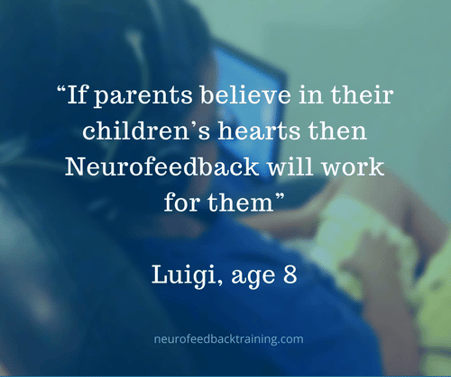
Jeanine called me about her 8-year-old son, Luigi, searching for a way to help him improve his performance at school. Luigi came into my office as an eager participant. He was happy to hear that he had the potential to be calmer and more focused and, better yet, that all he had to do to achieve these results was show up.
He enjoyed his favorite movie during his neurofeedback sessions as the brain training took place.
After 7 sessions the neurofeedback results were already evident. Jeanine happily reported:
“This is the best thing that’s ever happened to him because he is more focused and confident. He analyzes things more now and considers cause and effect… now he knows there are circumstances and he won’t do that (behavior) because he’d rather get the reward. The biggest change I’ve seen is that he’s more confident and positive. Children with focus challenges need a confidence boost.”
About his relationships, she commented:
“I see him interacting with other kids. It seems less about attention now and more about a mutual, equal relationship. The after-school teacher is also saying he seems more social and confident in his interactions.”
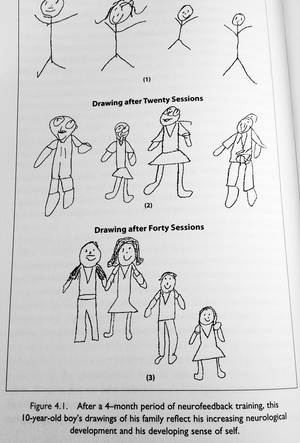 Luigi's teachers also took notice of his new ability to focus and finish his work. Not only were adults observing Luigi’s shifts, but tests showed his progress as well. On a recent test, he even scored within the top ten percentile for his grade.
Luigi's teachers also took notice of his new ability to focus and finish his work. Not only were adults observing Luigi’s shifts, but tests showed his progress as well. On a recent test, he even scored within the top ten percentile for his grade.
His handwriting improved drastically, he was tolerating more frustration and his therapist even started to decrease sessions.
A surprising effect for his mom was that Luigi’s drawings have become more detailed; stick figures are now prominent characters with a shape, form and title. This type of change has also been documented in the book Neurofeedback for Developmental Disabilities.
One heartwarming effect Jeanine reported was Luigi paying more attention to his younger siblings and taking on the role of the “elder” brother. She noticed while on a family stroll on the Coney Island boardwalk that he had taken his little brother’s hand because it was “necessary.”
Overall, Luigi is more buoyant, less anxious and less frustrated. He wanted to add his own review of his experience after reading this article. He stated, “if the parents believe in their children’s heart, (he feels neurofeedback) would work for them too.”
When we were creating videos of client reviews of neurofeedback, we asked Jeanine if she and Luigi would be willing to share their experience with NeurOptimal®. It had been two years since he started training, and we wanted to show the long term impact of brain training for children. She told us he would be thrilled to talk about his experience and that he still remembers doing the neurofedback program. Here's a video testimonial of his experience:
Boulder Neurofeedback Trainer Sees Results in Children and Parents Training Together
The number one reason for why we chose NeurOptimal® neurofeedback equipment for our center is because it is the best device for training children. It is safe and appropriate for use at any age. There are three main reasons we chose this system.
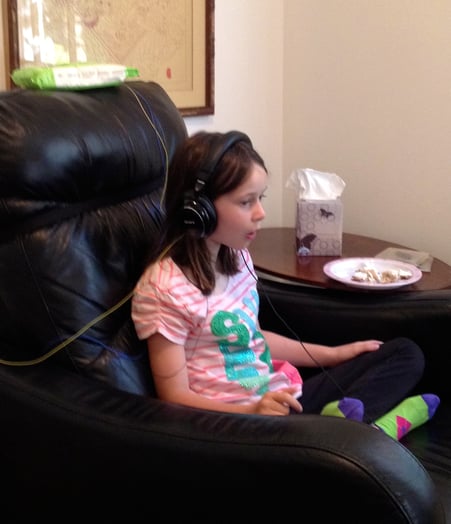
This is the number one question parents ask after finding out whether NeurOptimal® fits their needs.
Because the NeurOptimal system is purely a feedback system about brain wave activity, it does not cause side effects.
Other types of neurofeedback, called linear or protocol neurofeedback, operate differently and the neurofeedback trainer sets protocols to train the brain to go into certain brainwave frequencies.
Linear neurofeedback, while still appropriate for children, can produce temporary unwanted side effects. That is why an expert trainer is needed for this type of brain training.
When Doctors Sue and Valdeane Brown created NeurOptimal, they had children in mind. The technology works by synchronizing feedback millisecond-by-millisecond. The trainee is alerted to changes in brain waves through micro-interruptions in music. This brings the brain's attention to the changes, allowing it to be more aware of shifting states. This gentle alerting system is designed to mirror how the brain naturally optimizes itself.
Many behavioral, mental and emotional habits we see have a brain wave pattern connected to it. When you interrupt those waves, you become aware of those patterns, and transformation begins.
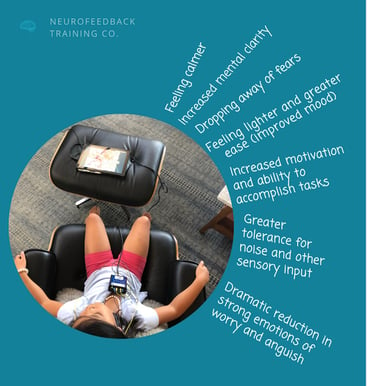 The main benefits parents look for in a neurofeedback program for their kids are 1) helping with school performance and 2) managing stress and emotional ups and downs.
The main benefits parents look for in a neurofeedback program for their kids are 1) helping with school performance and 2) managing stress and emotional ups and downs.
NeurOptimal® is designed to help with overall improvement in mental and emotional wellness. So even though parents may have specific goals, such as improving grades or minimizing performance anxiety, they also tend to see unexpected benefits, such as more restful sleep. Likewise, parents commonly report that bed wetting has stopped, even when that was not the primary reason for seeking neurofeedback.
As we saw with Luigi's story, parents often report that children's relationships with their siblings and friends improve as they start to manage their emotions better and experience more confidence. When bad emotional habits are interrupted, children quickly reset to match their current needs. They become calmer and better able to focus. This allows them to become more responsive and listen better.
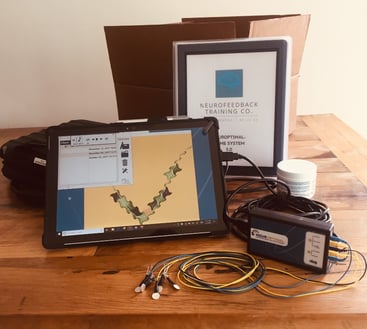 While Luigi trained in our neurofeedback center in New York, most parents choose to train their kids at home using a neurofeedback home kit. NeurOptimal® is easy to operate, and at-home training eliminates the commute.
While Luigi trained in our neurofeedback center in New York, most parents choose to train their kids at home using a neurofeedback home kit. NeurOptimal® is easy to operate, and at-home training eliminates the commute.
The NeurOptimal® equipment was designed to work as well at home as it does an office setting. The system is fully automated through software called AutoNav. This technology is key to providing the same quality training at home as you would receive in an office. There is no need to shift protocols or monitor settings. The system works through a dynamic play between the software and the changing brain, so that accurate feedback is given to the brain about its maladaptive patterns.
The advanced design of neurofeedback makes it a first-rate home system. The brain already knows how to optimize itself, and simply needs the right feedback to see its bad habits. NeurOptimal® uses moment-to-moment data on brain activity to provide feedback via micro-interruptions in music.
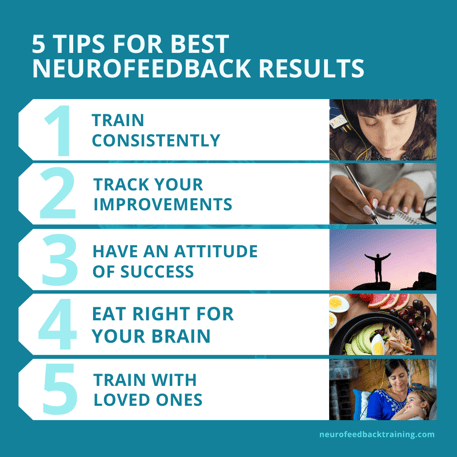 Parents are often concerned with the quality of neurofeedback when training at home. As we explained, NeurOptimal® is designed as a fully-automated system, so there is no need for a professional to be present during the training. Of course, there are some guidelines that will help you and your children gain the most from your brain training.
Parents are often concerned with the quality of neurofeedback when training at home. As we explained, NeurOptimal® is designed as a fully-automated system, so there is no need for a professional to be present during the training. Of course, there are some guidelines that will help you and your children gain the most from your brain training.
Make a schedule. With how busy schedules are today, sometimes the only obstacle to success is making sure sessions are on the family calendar. We advise parents using neurofeedback at home to create a schedule and stick to it. We see the best results when clients train consistently. This means setting realistic expectations for how brain training fits into a child's schedule. It is best to look for 30 minute periods of downtime, when the child can sit down and focus on one activity, such as watching a movie or reading a book.
Train together. We find that families who train together, grow together. When parents train alongside their kids, it benefits everyone. This is for a number of reasons. Namely, parents who train with their children are more likely to stick to schedule. Children are also more likely to be excited about activities they can do as a family. Watching mom or dad do their brain training sets a good example, and
Incorporate other healthy habits. Just like any wellness program, NeurOptimal® works best when taking a holistic approach. Combining neurofeedback with other healthy habits, like a regular sleeping pattern, healthy eating and physical exercise, will help optimize results. The great thing is that neurofeedback also helps promote these habits, making it easy to create a comprehensive wellness routine.
Incorporating these tips into your brain training can help you and your children see more successful outcomes, just like Luigi!
Natalie Baker has over 25 years of experience as a licensed psychotherapist and has been a NeurOptimal® neurofeedback trainer since 2011. She is the founder of Neurofeedback Training Co., which offers in-person sessions and runs the largest nationwide home rental program for NeurOptimal systems. Natalie also teaches meditation and Buddhist psychology and specializes in working with anxiety, stress, ADHD, and trauma.
Mindful parenting tips on how to meet the tasks and stressors of parenting and why neurofeedback training should be part of your self care regimen.
Parenting in this age of technology and speed is challenging. Learn 4 essential tips on mindful parenting from Buddhist Psychotherapist, Heather...
Does your teen struggle? Discover the early warning signs of teen stress and learn an action plan to help your teens cope with school, SATs, and...
Be the first to know about new blogs